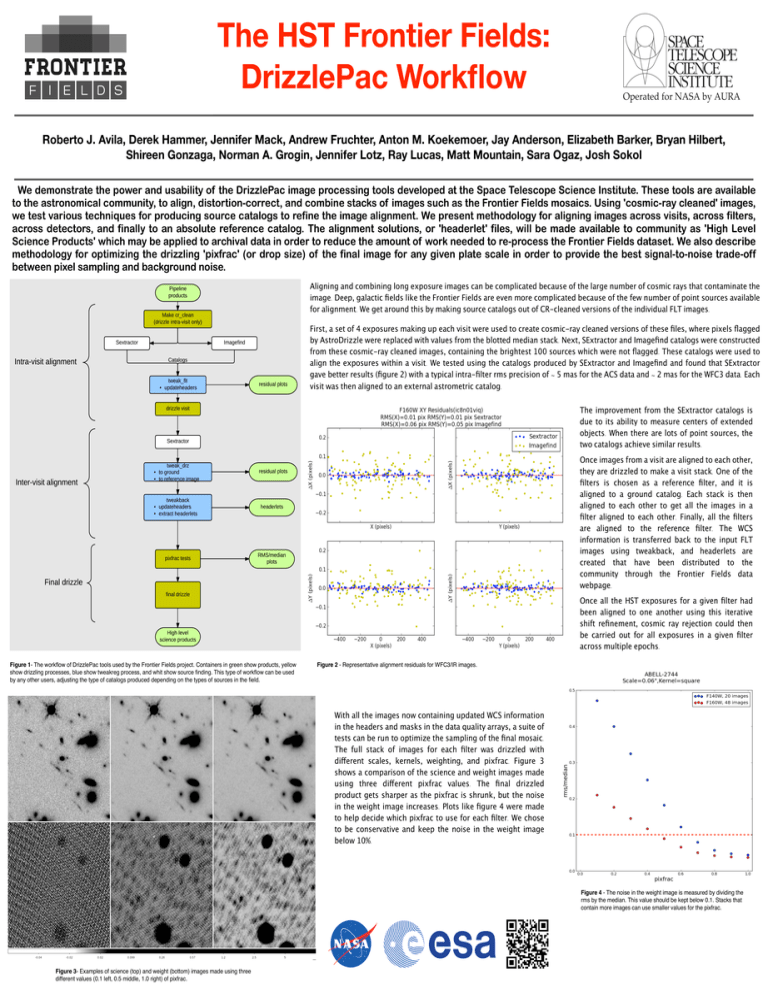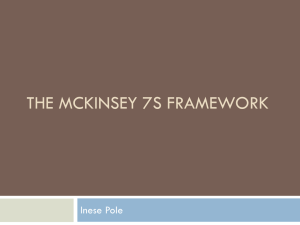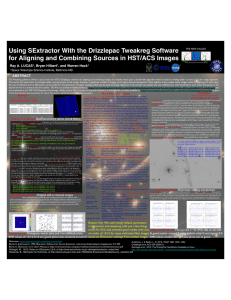The HST Frontier Fields: DrizzlePac Workflow
advertisement

The HST Frontier Fields: DrizzlePac Workflow Roberto J. Avila, Derek Hammer, Jennifer Mack, Andrew Fruchter, Anton M. Koekemoer, Jay Anderson, Elizabeth Barker, Bryan Hilbert, Shireen Gonzaga, Norman A. Grogin, Jennifer Lotz, Ray Lucas, Matt Mountain, Sara Ogaz, Josh Sokol We demonstrate the power and usability of the DrizzlePac image processing tools developed at the Space Telescope Science Institute. These tools are available to the astronomical community, to align, distortion-correct, and combine stacks of images such as the Frontier Fields mosaics. Using 'cosmic-ray cleaned' images, we test various techniques for producing source catalogs to refine the image alignment. We present methodology for aligning images across visits, across filters, across detectors, and finally to an absolute reference catalog. The alignment solutions, or 'headerlet' files, will be made available to community as 'High Level Science Products' which may be applied to archival data in order to reduce the amount of work needed to re-process the Frontier Fields dataset. We also describe methodology for optimizing the drizzling 'pixfrac' (or drop size) of the final image for any given plate scale in order to provide the best signal-to-noise trade-off between pixel sampling and background noise. Aligning and combining long exposure images can be complicated because of the large number of cosmic rays that contaminate the image. Deep, galactic fields like the Frontier Fields are even more complicated because of the few number of point sources available for alignment. We get around this by making source catalogs out of CR-cleaned versions of the individual FLT images. First, a set of 4 exposures making up each visit were used to create cosmic-ray cleaned versions of these files, where pixels flagged by AstroDrizzle were replaced with values from the blotted median stack. Next, SExtractor and Imagefind catalogs were constructed from these cosmic-ray cleaned images, containing the brightest 100 sources which were not flagged. These catalogs were used to align the exposures within a visit. We tested using the catalogs produced by SExtractor and Imagefind and found that SExtractor gave better results (figure 2) with a typical intra-filter rms precision of ∼ 5 mas for the ACS data and ∼ 2 mas for the WFC3 data. Each visit was then aligned to an external astrometric catalog. The improvement from the SExtractor catalogs is due to its ability to measure centers of extended objects. When there are lots of point sources, the two catalogs achieve similar results. Once images from a visit are aligned to each other, they are drizzled to make a visit stack. One of the filters is chosen as a reference filter, and it is aligned to a ground catalog. Each stack is then aligned to each other to get all the images in a filter aligned to each other. Finally, all the filters are aligned to the reference filter. The WCS information is transferred back to the input FLT images using tweakback, and headerlets are created that have been distributed to the community through the Frontier Fields data webpage. Once all the HST exposures for a given filter had been aligned to one another using this iterative shift refinement, cosmic ray rejection could then be carried out for all exposures in a given filter across multiple epochs. Figure 1- The workflow of DrizzlePac tools used by the Frontier Fields project. Containers in green show products, yellow show drizzling processes, blue show tweakreg process, and whit show source finding. This type of workflow can be used by any other users, adjusting the type of catalogs produced depending on the types of sources in the field. Figure 2 - Representative alignment residuals for WFC3/IR images. With all the images now containing updated WCS information in the headers and masks in the data quality arrays, a suite of tests can be run to optimize the sampling of the final mosaic. The full stack of images for each filter was drizzled with different scales, kernels, weighting, and pixfrac. Figure 3 shows a comparison of the science and weight images made using three different pixfrac values. The final drizzled product gets sharper as the pixfrac is shrunk, but the noise in the weight image increases. Plots like figure 4 were made to help decide which pixfrac to use for each filter. We chose to be conservative and keep the noise in the weight image below 10%. Figure 4 - The noise in the weight image is measured by dividing the rms by the median. This value should be kept below 0.1. Stacks that contain more images can use smaller values for the pixfrac. Figure 3- Examples of science (top) and weight (bottom) images made using three different values (0.1 left, 0.5 middle, 1.0 right) of pixfrac.









